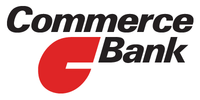Commerce Bancorp
 | |
| Industry | Bank holding company |
|---|---|
| Fate | Acquired by TD Bank, N.A. |
| Successor | TD Bank, N.A. |
| Founded | 1973 |
| Defunct | 2009 |
| Headquarters | Cherry Hill, New Jersey, U.S. |
| Products | Financial services |
Commerce Bancorp was a Cherry Hill, New Jersey–based bank created in 1973.[1] In 2007, it was purchased by Toronto-Dominion Bank, which merged Commerce with TD Banknorth to form TD Bank, N.A.; all of its banks and branches were given the TD Bank logo.
History
The company was founded in 1973 by fast-food restaurant franchise owner Vernon Hill, a graduate of the Wharton School of the University of Pennsylvania. Hill sought to bring fast food convenience to banking and expanded Commerce from one location to over 435 in thirty-three years. With growth of over sixty-five new stores opening annually, the company had planned to reach at least 800 stores by 2010. During the early-mid 2000s, television advertisements for Commerce Bank featured Kelly Ripa and Regis Philbin.[2] In 2006 Commerce purchased eMoney Advisor for $32 million in stock.[3][4]
Business model
Commerce's philosophy was that they were retailers, not bankers, and went so far as to call their various locations stores, not branches.
Features that Commerce offered its customers included:
- 7 day lobby or drive-thru hours, even in Center City Philadelphia and Manhattan, with the exception of branches in Paramus, NJ (Bergen County law requires most businesses to be closed on Sunday)
- Instant creation of ATM cards on the spot at the time of account opening
- No overdraft fees on debit card usage
- Free "Penny Arcade" coin counting machines for both customers and non-customers
- No-Fee Visa Gift Cards for customers
- Lollipops and dog biscuits in the lobby and drive-thru
- Foreign ATM fee reimbursement (if you maintain a daily balance of $2,500 through the statement cycle)
- "No Stupid Fees, No Stupid Hours"
Commerce Bank's business model generated what some called a cult following in the areas where they had stores. Commerce offered its customers merchandising giveaways such as coffee mugs, pens and pencils; in 2006 alone, the locations gave out 28 million free pens.
It was called Mc-Bank because Vernon Hill used his knowledge of the fast food chains he owned and applied it to the banking industry.
This model was described in the case of study HBS 9-603-080 from Harvard Business School, published in 2002.
Mascots
As with many companies, Commerce Bank had an official mascot: Mr.C. Mr.C was the Commerce Bank logo, a red c, with black arms and black legs. He always had a huge smile and large bushy eyebrows.
Buzz Bee was also a mascot for the bank. However, Buzz was used primarily as an internal mascot for the "WOW! members" (i.e. the employees).
Both of these "mascots" were liquidated as a result of the TD acquisition.[2]
Expansion
While most of Commerce Bank's growth was organic, there were five large acquisitions:
- early 1990s - Four branch offices were purchased from Long Island-based Anchor Savings Bank: Cherry Hill Mall, Bellmawr, Woodcrest and West Deptford.
- January 21, 1997 - Independence Bancorp, Inc. became Commerce Bank/North.
- August 13, 1998 - Community First Banking Company and its subsidiary Tinton Falls State Bank became Commerce Bank/Shore.
- September 17, 1998 - Prestige Financial Corp. and its subsidiary, Prestige State Bank became Commerce Bank/Central
- July 25, 2005 - Palm Beach County Bank established Commerce Bank in Southeast Florida.
Commerce Bank Harrisburg
Commerce Bank had an independent franchise[5] in the Harrisburg, Pennsylvania region. Pennsylvania Commerce Bancorp, Inc.,[6] which is now known by the name Metro Bancorp Inc, had 33 stores in Berks, Cumberland, Dauphin, Lancaster, Lebanon and York counties.[7] The headquarters for Commerce Bank Harrisburg was in Swatara Township, just outside Harrisburg. Commerce Bancorp shared a call center with Pennsylvania Commerce Bancorp near Harrisburg, PA. Commerce Bancorp owned approximately 11% of the stock of Pennsylvania Commerce Bancorp.
"Commerce Bank" brand

Several banks in the United States have traded under the name "Commerce Bank" or similar names, leading to brand confusion. As a result, Commerce Bank and Trust Company in Worcester, Massachusetts successfully sued TD Bank to stop it from using the name "TD Commerce Bank", which it had planned to trade under following its acquisition of Commerce Bancorp. However, Commerce Bancshares, in Kansas City, Missouri, and Commerce National Bank, in Columbus, Ohio both still exist and do business under their respective names, even though they are unaffiliated with the now-defunct Commerce Bancorp.
TD Bank acquisition

On October 2, 2007, TD Bank Financial Group (TDBFG) and Commerce Bancorp, Inc. announced that they had signed a definitive deal agreement for TDBFG to acquire Commerce Bank in a 75% stock and 25% cash transaction valued at US$8.5 billion.
Under the agreement, Commerce shareholders received 0.4142 shares of a TD common share and US$10.50 in cash in exchange for each common share of Commerce Bancorp Inc. The consideration was negotiated on the basis of US$42.00 per share value for Commerce Bank. The transaction value based on the October 1, 2007 closing price of TD common shares is $42.37.
References
- ↑ "Company History". TD Bank. Retrieved 20 October 2010.
- 1 2 Blumenthal, Jeff (June 16, 2010). "TD mascot sporty, fun and 'strains intellectual scrutiny'". Philadelphia Business Journal. Retrieved 20 October 2010.
- ↑ "Commerce Bancorp finishes eMoney purchase". Philadelphia Business Journal. February 24, 2006. Retrieved July 2, 2013.
- ↑ Jeff Blumenthal (January 4, 2006). "Commerce Bancorp buys eMoney Advisor". Philadelphia Business Journal. Retrieved July 2, 2013.
- ↑ http://www.commercepc.com/inside_commerce/about_us/index.cfm
- ↑ http://www.commercepc.com
- ↑ http://www.commercepc.com/locations_hours/all_counties.cfm
External links
- Riley, Clint (May 21, 2003). "Fast-Growing Commerce Bancorp Counts On Political Ties". KRTBN Knight-Ridder Tribune Business News: Hackensack Record (on New York University (NYU) Leonard N. Stern School of Business website). Retrieved 2010-08-30.